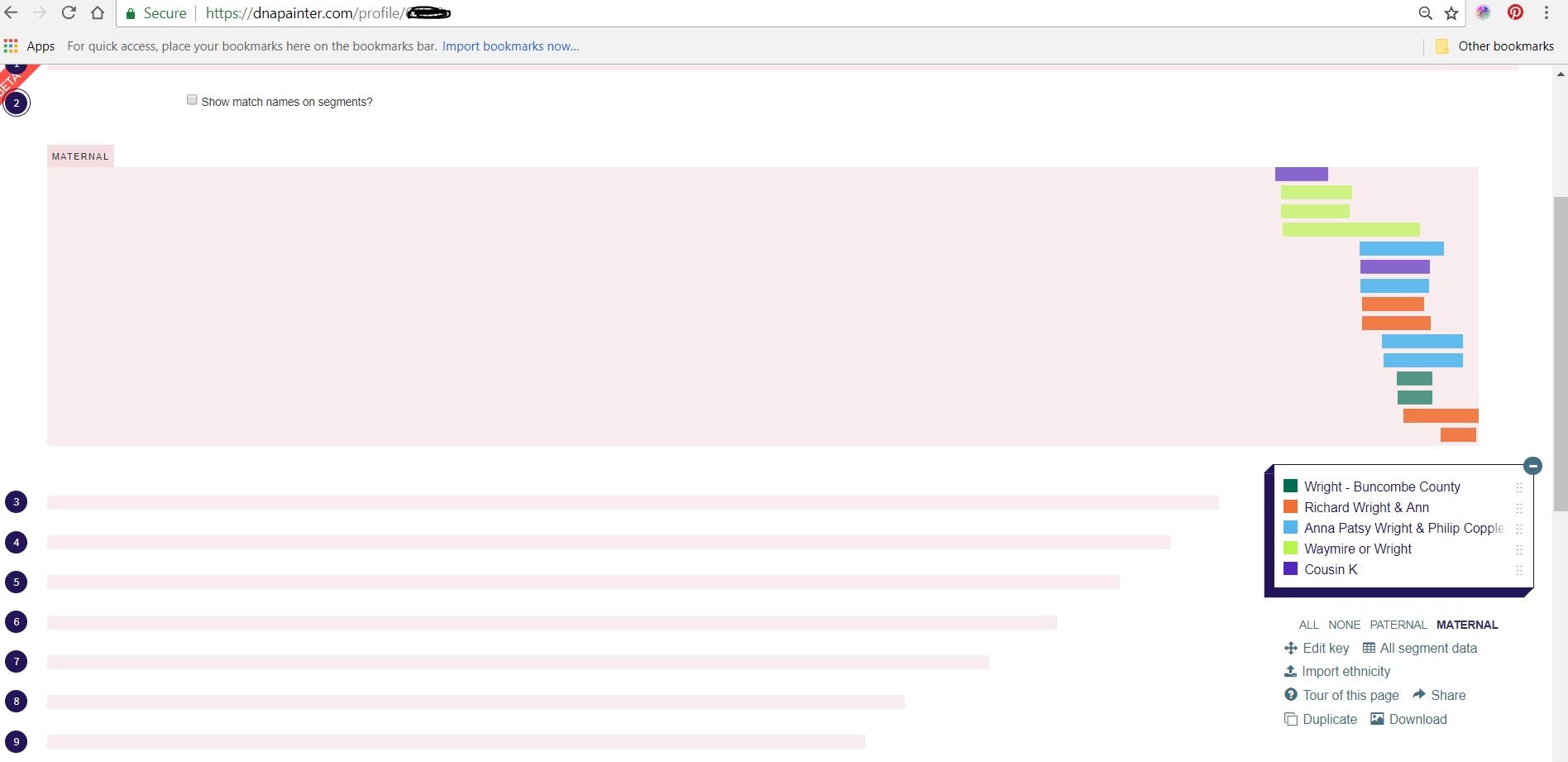
What is this picture telling us? It is from a tool called DNA Painter (https://dnapainter.com/) I am focusing on a specific set of segments on chromosome 2 on my mother’s side (hence the wide bar for chromosome 2 and the pink color for the chromosomes shown.)
Before using this tool, I had already gotten my DNA tested, as had both my parents, 2 of my siblings, and numerous known 1st, 2nd and 3rd cousins. (Second cousins share a pair of great-grandparents; third cousins share a pair of great-great grandparents.) In addition, I’ve already worked on determining who is the Most Recent Common Ancestor (MRCA) between my DNA match and me, using census records, vital records (marriage, birth, death), land deeds, and so on.
Based on my “paper” research and my DNA matches, each cousin (represented by a single color bar, except for cousin K in purple who has two bars) matches me, matches my mom, and matches each other. This is known as triangulation (if A = B and B = C, then A = C) and is indicative of a shared ancestor (or ancestors) at some point back in time. The paper research points to Richard Wright and his wife Ann (maiden name unknown) being the MRCA for all of us.
For some of the cousins above, the MRCA couple for them and me is Anna Patsy Wright and her husband Philip Copple (key = turquoise). For other cousins, the MRCA couple is Richard Wright and his wife Ann (maiden name unknown) (key = orange). Anna is the granddaughter of Richard and Ann, so in actuality, the segments assigned to her are segments she inherited from Richard or Ann. (Thus, all the turquoise segments could in fact be colored orange.)
The point of using both turquoise and orange is to show that some of the people who match me are also descendants of Anna Wright, and other cousins (whose MRCA with me is Richard and Ann, rather than Anna and Philip) are descendants of someone other than Anna – specifically, from one of her paternal uncles or aunts. (If they had descended from one of Anna’s own siblings, then the MRCA would not have been Anna’s grandfather but instead her father Amos Wright.)
Cousin K is being highlighted in purple to emphasize K’s two segments shared with me. (If I were keeping to the color coding, one segment of K’s would be chartreuse, and one would be turquoise.)
Notice how the segments seem to be staggered; their starting ends line up. These represent crossover points, here indicated by the vertical dark lines. Since I inherited the entire segment from my maternal grandmother, it’s more likely these crossovers occurred sometime in the past, and represent segments inherited by her from different ancestors on the Wright line.

The teal segments, representing matches who have a Wright ancestor from Buncombe County, North Carolina, are unexpected matches. Meaning, my maternal Wright line has no (apparent) tie to Buncombe County, NC –that’s too far west of where “my” Wright line lived. That being said, because they match me and match the other cousins who are known to be Patsy Wright’s descendants and/or Richard Wright descendants, they must be relatives. Our common ancestor likely goes back further than Richard – the fact that the segments are shorter than the others would seem to confirm that assumption. (That being said, due to the randomness of DNA inheritance, there is not always a correlation between length of segment and distance of relationship.)

The as-yet-unknown ancestor segment is in chartreuse, and represents the segment of chromosome 2 from the first crossover (vertical line) to the second crossover. I’ve labeled it “Waymire or Wright” in the legend, as it likely relates to my Wright line, and cousins who share this segment have Waymire/Wehmeyer ancestors in their tree. And that matters because the Waymire and Wright families lived right next door to each other in Randolph County, NC circa 1770’s. It’s the tiniest of clues to go on, and may not be accurate; more research, and more cousins tested, is needed to solve the puzzle.
The red arrow points to the “Richard Wright and Ann” segment. What’s important to mention here is that I call it the “Richard Wright and Ann” segment because that’s as far back as I can determine. Therefore, it’s a convenient label. However, it may not actually have been inherited through the Wright line. If the segment was passed down through Richard, but he inherited it from his mother, then it would technically be a “Becraft” segment, as Richard’s mother was Esther Becraft. If the segment was passed down through Richard’s wife Ann, it wouldn’t be a Wright segment at all – but we don’t have a surname for Ann, so it’s easier to label this segment on chromosome 2 as a “Wright” segment.
The fun of mapping segments, though, is that it assists you in quickly figuring out how your DNA match may be related to you. If I get a new match tomorrow, say, on MyHeritage, and they match me maternally on one of the segments shown above, I know they are related to me through my Wright line, and how far back is really the only question. I don’t need to consider any of my other maternal ancestors.
Mapping can be done at a much closer level – assigning your 4 grandparents to segments of each of your chromosomes (1 – 22, and the X). You’ll need your siblings to test with you. I will cover that in a later post.




